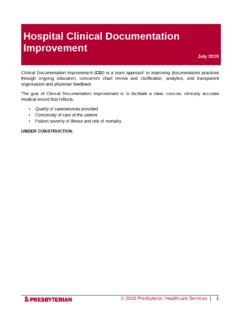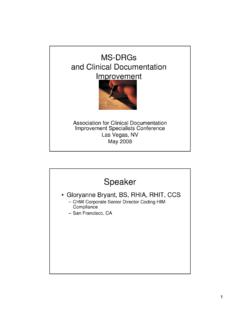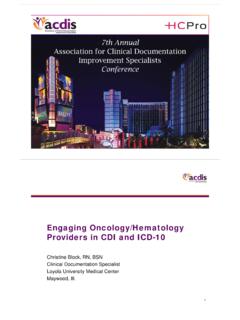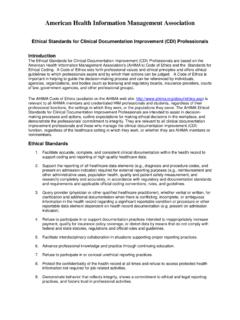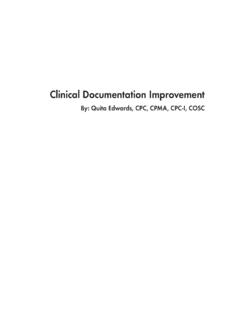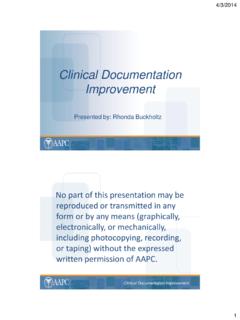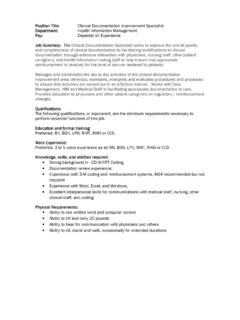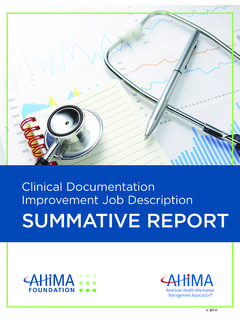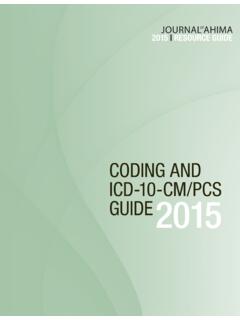Transcription of Ethical Standards for Clinical Documentation Improvement ...
1 10/28/2016 Ethical Standards for Clinical Documentation Improvement (COl) Professionals (2016) Ethical Standards for Clinical Documentation Improvement (CDI) Professionals (2016) Introduction The Ethical Standards for Clinical Documentation lmprovement (COl) Professionals are based on the American Health Information Management Association's (AHIMA's) Code of Ethics and the Standards for Ethical Coding. A Code of Ethics sets forth professional values and Ethical principles and offers Ethical guidelines to which professionals aspire and by which their actions can be judged. A Code of Ethics is important in helping to guide the decision-making process and can be refere nced by individuals, agencies, organizations, and bodies (such as licensing and regulatory boards, insurance providers, courts of law, government agencies, and other professional groups). The AHIMA Code of Ethics is relevant to all AHIMA members and credentialed HIM professionals and students, regardless of their professional functions, the settings in which they work, or the populations they serve.
2 The AHIMA Ethical Standards for Clinical Documentation Improvement Professionals are intended to assist in decision making processes and actions, outline expectations for making Ethical decisions in the workplace, and demonstrate the professionals' commitment to integrity. They are relevant to all Clinical Documentation Improvement professionals and to those who manage the Clinical Documentation Improvement (COl) function, regardless of the healthcare setting in which they work, or whether they are AHIMA members or nonmembers. Ethical Standards I. Facilitate accurate, complete, and consistent Clinical Documentation within the health record to demonstrate quality care, support coding and repmiing of high-quality healthcare data used for both individual patients and aggregate reporting. 2. Support the reporting of healthcare data elements (e .g. diagnoses and procedure codes, hospital acquired conditions, patient safety indicators) required for external reporting purposes (e.)
3 G. re imburseme nt, value based purchasing initiatives and other administrative uses, population health, quality and patient safety measurement, and research) completely and accurately, in accordance with regulatory and Documentation Standards and requirements, as well as all applicable official coding conventions, rules, and guidelines. 3. Query the provider (physician or other qualified healthcare practitioner), whether verbal or written, for clarification and/or additional Documentation when there is conflicting, incomplete, or ambiguous information in the health record regarding a significant reportable condition or procedure or other reportable data element dependent on health record Documentation ( present on admission indicators). Query the provider if the Documentation describes or is associated with Clinical indicators without a definitive relationship to an underlying diagnosis, or provides a diagnosis without tmderlying Clinical validation.
4 4 . Never participate in or support doc umentation practices intended to inappropriately increase payment, to qualify for insurance policy coverage, to avoid qua lity reporting issues, or to skew data by means that do not comply with federal and state statutes, regulations and official rules and guidelines. 5. Facilitate interdisciplinary education and collaboration in situations supporting proper Documentation , reporting and data collection practices throughout the facility. 6. Advance professional knowledge and practice through continuing education. 7. Never participate in, conceal unethical reporting practices or support Documentation practices intended to inappropriately increase payment, qualify for insurance policy coverage, or distort data by means that do not comply with federal and state statutes, regulations and official coding rules and guidelines. 8. Protect the confidentiality of the health record at all times and refuse to access protected health information not required for job-related activities.
5 9. Demonstrate behavior that reflects integrity, shows a commitment to Ethical and legal reporting practices, and fosters trust in profess ional activities. I 0. Collaborate in a team environment with the coding, quality, and other professionals in the organization. 11. Report unethical, noncompliant, or unlawful activity to the organization's compliance officer or similar official responsible for monitoring such activities. How to Interpret the Ethical Standards #.W8 Nrkvkrlcs 1/6 10/28/2016 Ethical Standards for Clinical Documentation Improvement (CDI) Professionals (2016) Example I : Acute Hypoxic Respiratory Failure is documented for a patient with COPD exacerbation and the patient's Clinical Documentation lacks supportive Clinical indicators of Acute Respiratory Failure. Example 2: Sepsis diagnosed without supporting Clinical indicators or not meeting all of the facility's established Systemic Inflanunatory Response Syndrome (SIRS) criteria and one or more of the criteria could be explained as due to another cause.
6 Example 3: Provider Documentation within the record. 52-year-old female presents with chest pain/pressure. Pain is not sharp or dull in nature and does not radiate. Slight relief while sitting up. No past history of heart issues. Family history of CAD. Vital signs normal. ECG, chest x-ray, and routine blood test to include troponin T ordered. ECG and chest x-ray normal. RIO GERD. Diagnosis: CAD. Suggested action: A query should be sent to the provider as the Documentation does not state whether GERD was ruled out; nor do the Clinical indicators support the diagnosis of CAD. Clinical Documentation Improvement professionals shall: Participate in the development of query policies that support Documentation Improvement , and meet regulatory, legal, and Ethical Standards for coding and reporting. See AHIMA Practice Brief, Guidelines for Achieving a Compliant Ouery Practice Example 4 : Query the provider for clarification: A patient is admitted with pneumonia.
7 73-year-old male presents with chest pain, dyspnea and productive cough. Physician exam reveals bradycardia and crackles. Admission diagnosis: Pneumonia. Day 1 progress note: Chest pain, dyspnea, cough, crackles, and fever were present on admission. Antibiotics were ordered. Day 2 progress note: Temperature degrees; continue antibiotics; sputum culture positive for Streptococcus pneumoniae: diagnosis bacterial pneumonia. Day 3 progress note: Discharge patient. Discharge diagnosis: Pneumonia. The provider should be queried for greater specificity of pneumonia and if there is a link between the sputum culture results and the pnew11onia. Query the provider for clarification when Documentation in the health record impacts an externally reportable data element and is illegible, incomplete, unclear, inconsistent, or imprecise. The Clinical Documentation must reflect an accurate and concise representation of the patient's Clinical condition(s).
8 Query the provider for clarification when a diagnosis is not supported by the Clinical indicators in the health record. These types of instances may re quire referral per the facility's internal escalation policy. Use queries as a communication tool to improve the quality of health record Documentation , not to inappropriately increase reimbursement or misrepresent quality of care. Example 5: Policies regarding the circumstances when providers should be queried are designed to promote complete Documentation , regardless of whether reimbursement will be affected. Clinical Documentation Improvement professionals shall not: Query the provider when there is no Clinical information in the health record prompting the need for a query. Example 6: Query the provider regarding the presence of gram-negative pneumonia on every pneumonia case, regardless of whether there are any Clinical indicators (including treatment) of gram-negative pneumonia documented in the record.
9 Example 7: Query the provider for sepsis when the Clinical indicators are only suggestive of urinary tract infection, such as low grade fever, increased WBCs, and there were no blood cultures obtained. 4. Never participate in or support Documentation practices intended to inappropriately increase payment, to qualify for insurance policy coverage, to avoid quality reporting issues, or to skew data by means that do not comply with federal and state statutes, regulations and official rules and guidelines. Clinical Documentation Improvement professionals shall: 4 .1. Facilitate clear, accurate and complete Documentation that supports reporting of diagnoses and procedures such that the organization receives proper reimbursement to which the facility is legally entitled, remembering that it is tmethical and m d= 301868#. W BN rkvkrlcs 316 10/28/2016 Ethical Standards for Clinical Documentation Improvement (COl) Professionals (2016) permanent part of the medical record.
10 Copying and pasting another clinician's Documentation without identification of the original author and date Supporting Documentation practices that knowingly result in reporting incorrect present on admission indicator(s) Engaging in the utilization of leading provider queries 8. Protect the confidentiality of the health record at all times and refuse to access protected health information not required for job-related activities. Clinical Documentation Improvement professionals shall: Protect all confidential information obtained in the course of professional service, including personal, health, financial, genetic, and outcome infonnation. Access only that information necessary to perform their duties. 9. Demonstrate behavior that reflects integrity, shows a commitment to Ethical and legal reporting practices, and fosters trust in professional activities. Clinical Documentation Improvement professionals shall: Act in an honest manner and bring honor to self, peers, and the profession.

